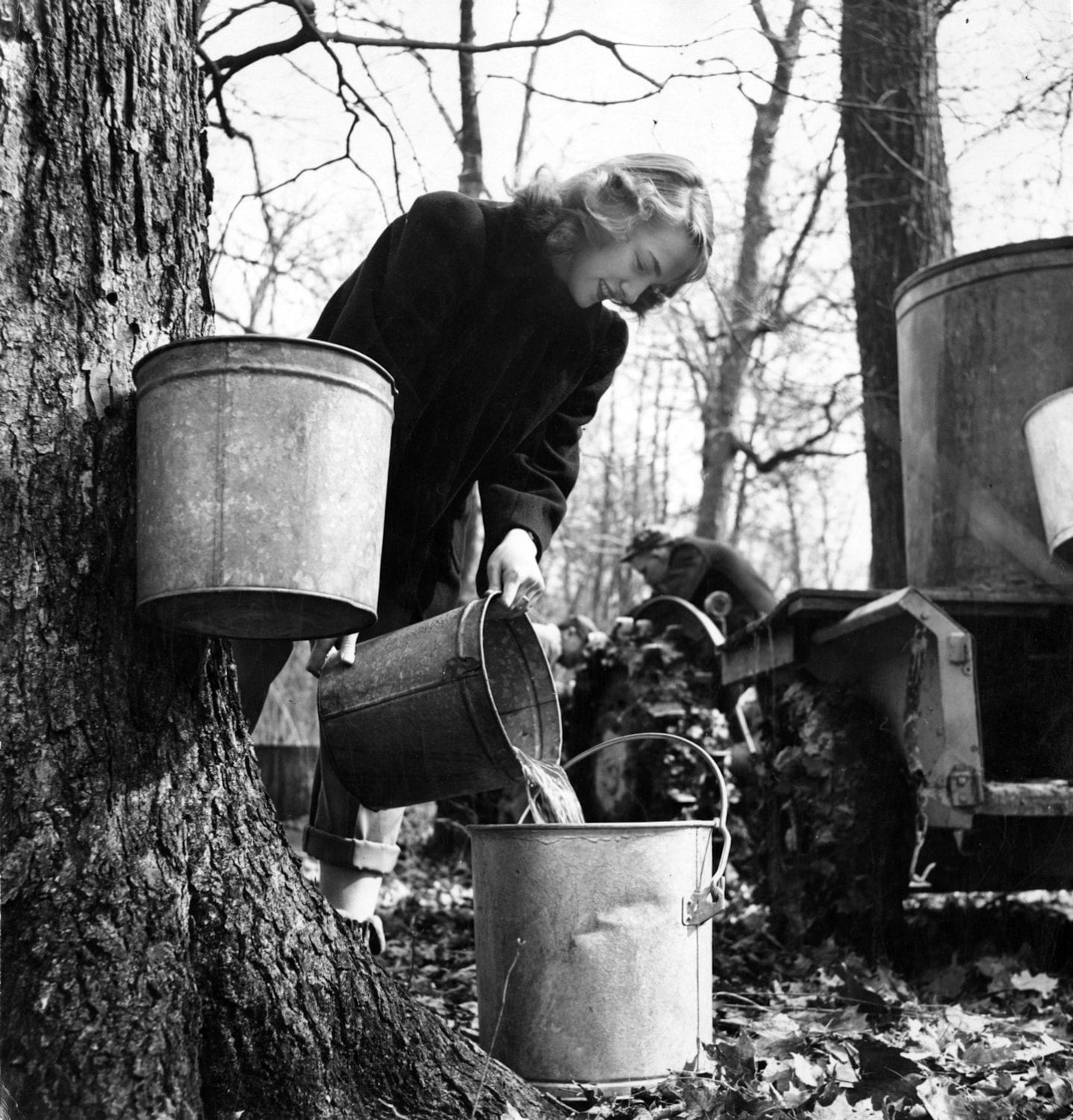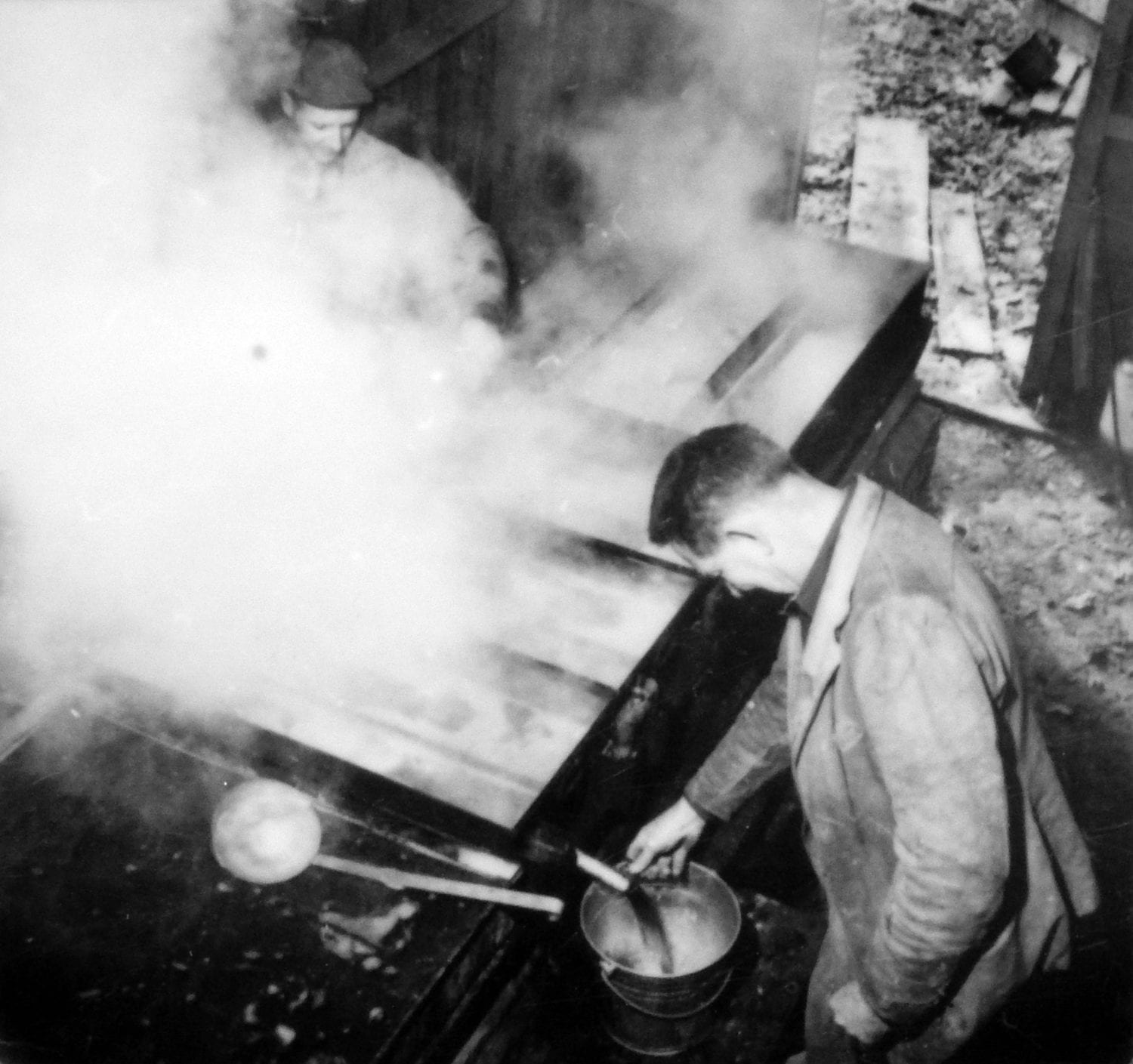March is maple sugaring time in Ohio. Louis Bromfield, with help from family and friends, tapped the same trees that Native Americans and early pioneer settlers did near the wooded areas by Pugh Cabin and Ferguson Farm. Using metal buckets and a wood-fired evaporator, the maple sap was collected by hand and carried to the sugar shack to boil the sap into pure maple syrup. The tradition continues during the Malabar Farm’s Annual Maple Syrup Festival which is held the first two weekends in March. Maple syrup,fudge and other maple products are for sale in the State Park gift shop located in the The Visitors Center.
What Goes Up Tastes Good Going Down
By David Wiesenberg
The Pleasures of Maple Sugaring
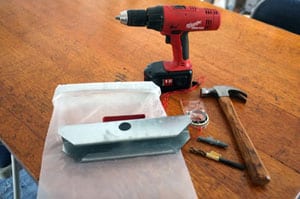
Of all the food or drink items that can be made at home, one that easily claims gourmet quality is maple syrup. Wine?—forget it. All the variables of weather and soil go into wine making and having a well-tuned and talented palate is a great asset, but it’s actually difficult to make maple syrup that is anything less than delicious.
Plus, for me, it is the time at the end of winter when, even if it doesn’t feel like it in my barely-heated office, the natural world knows that spring is arriving. It is a first sign—and an opportunity to get outdoors without the burden of taking on a big chore. It’s an activity that connects me with America’s founding fathers who revered maple syrup not only because it cut into the British sugar trade. Making maple syrup connects me with the area’s native people who taught its production to the settlers and which may be the one remaining non-European-introduced agricultural practice that still resembles its original procedures, and tapping maple trees connects me with modern scientists who are still trying to understand the process.
Here’s how to do it. First you have to pick a sugar or black maple tree and for many people, identifying trees with the leaves on them is easier than trying to figure out winter silhouettes. Sugar-maple leaves usually have five lobes and the center lobe (the one that points up on the flag of Canada) has parallel sides. The edges of the leaves don’t tend to droop and the underside of the leaf is much paler than the top. The fruit-wing pairs are at an angle that is tighter than a right angle and they ripen in the fall. If you have access to multiple trees, pick the one with the largest and highest canopy; the tree that has the most exposure to sunlight.
For winter identification, sugar-maple bark is dark gray and has vertical cuts between the furrows of bark as if the sides of the bark are curling up. The overall profile is egg-shaped, the twigs are slender and dense, and if you have good eyesight you can see that the small branches grow opposite each other and that there may be stalks (but without the fruit) still visible at the ends. Finally, if identification has got you stumped, other maple trees such as the Red Maple also produce sap that is fine for syrup; it’s just that this sap isn’t as concentrated, and the collecting season is shorter than for sugar-maple trees.
Trees for tapping must be at least twelve inches in diameter at breast height, and if this is the first year you are tapping, make your hole on the south side of the tree. In subsequent years (or if the tree has been tapped previously), locate the new hole about six inches away, going around the tree, and up or down about four inches. Eventually, you will work all the way around the tree.
Drill your hole with a cordless drill and a sharp, three-eighths-inch bit as you want a good clean cut across the pores. Use a depth-stop set at one-and-a-half inches (a piece of masking tape works fine) so that there will be a void behind the tap, called a spile. Angle the drill bit so that it is going slightly upward into the tree (ideally, this would be at an 85º angle from the perpendicular). Keep your eye on the shavings that come out of the hole as you want to see clean, white wood. After you’ve drilled your hole, don’t—whatever you do—blow out the hole. Keep your bacteria to yourself; the tree will replace the wood where the hole is just fine.
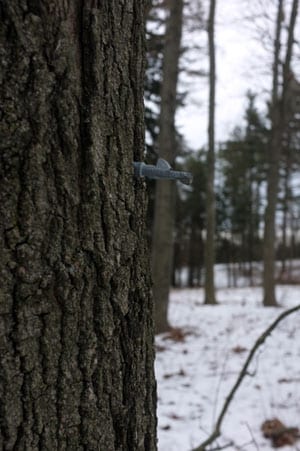
Tap the spile in lightly, not splitting the bark and not requiring a big effort to withdraw it when the season is over. I use heavy plastic bags that are suspended from a galvanized steel frame which hang on the spile. When I collect my sap, I just carry an empty five-gallon watercooler jug out to the tree and pour the sap into the jug. The sap in the jug then gets poured into a pot on our woodburning stove. If there is more sap than the pot will hold, the jug goes outside on the porch, so typically, we have two jugs in play during the season.
The season ends exactly when the tree begins to form leaf buds. A couple of things will be happening to the sap at this time. One is that it will start to look cloudy or milky, and the other is it will start to taste like green wood. You don’t want to mix this sap in with the syrup that is being cooked down.
Homemade syrup will likely be darker than the stuff you find in the grocery store. Darker syrup has more flavor (and boiling it over a longer period of time is another reason why syrup is darker). If you just want to sample the maple sugaring process and make enough for a pancake breakfast or two, keep in mind that the early sap has the highest concentration of sugar. Also, early in the season, you are ahead of any insects that hatch which might find their way into your collecting bag or bucket.
I am still trying to work out the best time to get the taps in, but where I live in Wooster, the middle of February seems about right (okay, having put my taps in by the fifth last year, the tree was already running and I had several gallons of sap by mid-February).
Here are a couple of additional tips. If you have lots of lovely wallpaper in your home, don’t boil your sap like we do. Adding the moisture to your house in winter is great for your sinuses but can have an effect on the glue holding up your wallpaper. We also finish our syrup on the kitchen stove where we have more control over temperature and thickness. The formula for finishing is to boil the sap at exactly 7.1 degrees Fahrenheit above the boiling point of water (which can vary at different altitudes and barometric pressures). A candy thermometer is adequate or use a hygrometer to measure specific gravity.
It takes about forty gallons of sap to make a gallon of syrup and we get about twenty-five to thirty gallons of sap from each tree. Staying ahead of one tree is a breeze; two trees will keep you busy, and more may make the project like a commercial enterprise. On a couple of days during the season, particularly after a cold night, a rainy morning, and a bright, invigorating day, you may get as much as five gallons from a single tree. City trees come into bud a couple of weeks earlier than trees in a rural woodlot.
How does the water get from the soil and up the tree? After all, trees have no pumps as vertebrate animals do and hardwood trees such as maples can grow pretty tall.
The sap in a tree rises about one inch every two-and-a-half seconds during the spring and summer. This is about ten times faster than blood flows through our capillaries. And this occurs in trees with only the use of solar energy and without any moving parts.
Liquids have cohesion from molecule to molecule (unlike gases) and water, which is what sap primarily comprises, has a high tensile strength about a tenth that of steel when pulled—that is, when placed in tension, such as when liquid is drawn up a straw.
The tubes of the tree’s conduit system, called the xylem, are both water-loving (like extremely smooth, clean glass) and comprise dead cells. Both these conditions reduce the likelihood that bubbles will form to break the flow.
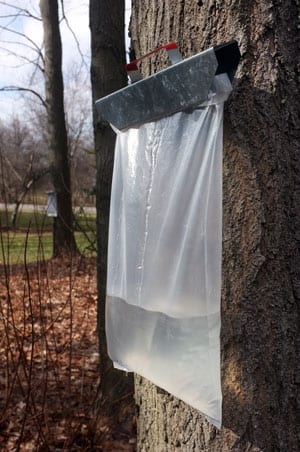
Evaporation of water from the leaves’ cells into the air spaces inside the leaf (remember the “spongy layer” from high school biology?) creates enough negative pressure to pull the sap up the tree. This process, grounded in principles of flow dynamics, creates a pull that is about a thousand times stronger than the circulation pressure pumped by the human heart.
Because the cell walls of leaves are made of cellulose, a felt-like material similar to a finely-woven fabric, it is watertight. This is the barrier where the water meets the air inside the leaf and which prevents air from being sucked back down the tree. The small diameter of the tubes in the tree’s conduit system, and the liquid’s surface tension, keep flow-stopping bubbles from occurring from the branch-tip or leaf end of the tree.
However, overcoming the soil’s hold on water is the tree’s hardest job. Some of the water in the soil moves downward due to gravity but a lot of water is held between soil particles and small pockets of air in the ground. A pound of soil has about eleven acres (~500,000 square feet) of surface area. This action requires more suction than overcoming gravity and the laminar-flow resistance inside the tree.
But for us tappers of maple trees, two processes are still unclear to tree scientists: how does the tree begin the process of drawing up sap in the spring (what turns it on and how does it start when all the conduits are empty), and how does the sap rise before there are leaves in which the evaporation, sometimes called transpiration, occurs?
For me, there is nothing more heart and hearth warming than pursuing the homespun craft of gathering and boiling down maple sap. Though an old-time practice, there are still intriguing mysteries in the process. It is part of the magic of the outdoors and a flavorful way to connect with the growing season to come.

